If a dog refuses to eat from a bowl, it can be a cause for concern for any owner.
After all, dogs usually happily approach their bowl to enjoy delicious food.
However, sometimes a pet may ignore a filled bowl, leaving the owner perplexed.
There can be many reasons for this behavior: from ordinary stress to serious health problems.
It is important to understand why a dog refuses to eat in order to quickly solve this problem and restore your pet's appetite.

Stress and changes in the environment
Dogs are creatures of habit, and any change in their lives can cause stress, which can affect their appetite.
Moving to a new place of residence, the appearance of another pet or family member in the house, renovations - all this can cause the dog to refuse food. In such situations, it is important to give the dog time to get used to the new circumstances, surround it with care and attention.
Health problems
Loss of appetite is often the first sign of illness. Dental problems, upset stomach, infections, or more serious ailments can cause a lack of appetite.
If the refusal to eat is accompanied by other symptoms such as lethargy, vomiting, or diarrhea, you should immediately contact your veterinarian for diagnosis and treatment.
Quality and taste of food
Sometimes the cause is in the food itself. Dogs, like people, have their own taste preferences. A sudden change in the type of food or its brand can cause a refusal to eat.
Poor quality or spoiled food can also be the reason why a dog does not want to eat from a bowl. It is worth checking the expiration date of the product and trying to offer your pet another type of food.
Inconvenient bowl or its location
The shape, size and material of the bowl play an important role in the comfort of the dog while eating. Too deep a bowl can be uncomfortable for dogs with short muzzles, and a metal bowl can frighten them with the sound of the collar jingling against the edges.
The location of the bowl also matters – the dog may refuse to eat if the bowl is in a noisy or busy place.
Spoiled and Manipulated
Some dogs become picky eaters because their owners are overprotective. If your pet is used to getting treats from the table or special additives to their main food, they may start ignoring their regular food, expecting something tastier.
In such cases, it is necessary to be firm and return to the correct feeding regime.
Age-related changes
As dogs age, their eating habits and needs may change. Older dogs often eat less due to decreased activity and changes in metabolism.
They may also have dental or digestive problems, which can also affect their appetite. These dogs may require special food that is appropriate for their age and health.
Social factors
In homes with multiple dogs, competition for food sometimes arises. More timid dogs may hesitate to eat if they feel that other pets may intimidate them. To solve this problem, you can feed the dogs in different rooms or provide them with separate eating areas.








